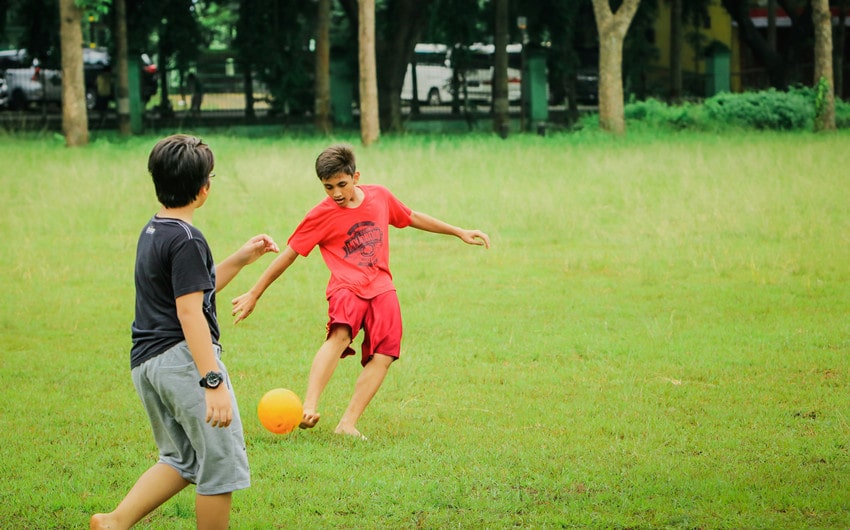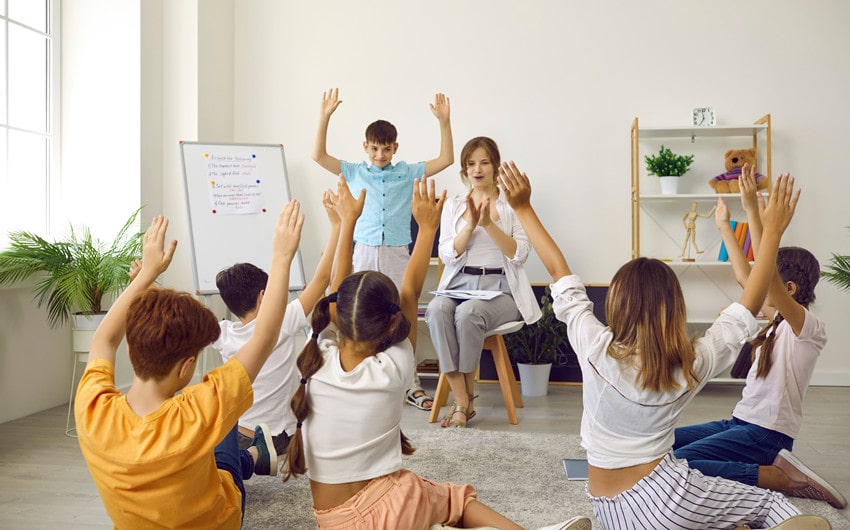29 Fun Games To Play At School That Everyone Will Enjoy
School isn’t just about lessons and homework; it’s also a place where friendships are built and creativity flourishes. One of the best ways to make the most of your time at school is by engaging in fun games that bring everyone together.
Whether you’re looking for something active to play during recess or a game that sparks creativity in the classroom, there are plenty of fun games to play at school that can make your day more enjoyable. These games not only offer a break from the routine but also help develop teamwork, problem-solving skills, and loads of laughter.
Outdoor Games

Outdoor games are perfect for recess or physical education classes, allowing students to engage in physical activity, build teamwork skills, and enjoy fresh air.
1. Tag Variations
- Suitable Environment: Playground, open field
- Group Size: 4 or more players
- How to Play: Tag is a timeless game with many variations, each adding a unique twist:
- Freeze Tag: One player is “it” and tags others to freeze them. Frozen players must stay still until another player unfreezes them by touching them. The game continues until everyone is frozen or a set time limit is reached.
- Shadow Tag: Players must avoid stepping into the shadow of the person who is “it.” If their shadow is touched, they become the new “it.”
- Blob Tag: When a player is tagged, they join hands with the person who tagged them, forming a “blob.” The blob grows as more players are tagged, making it harder to avoid being caught.
Why It’s a Good Game: Tag variations are excellent for promoting physical fitness, agility, and strategic thinking. They also encourage social interaction and cooperation, especially in versions where players must work together to unfreeze teammates or form a “blob.”
2. Capture the Flag
- Suitable Environment: Large open space, field, or playground
- Group Size: 10 or more players, divided into two teams
- How to Play: Each team hides a flag (or any object) in their territory. The objective is to capture the opposing team’s flag and bring it back to your side without getting tagged. Players who are tagged in enemy territory go to “jail” and can only be freed by a teammate. The game ends when a team successfully captures the opponent’s flag.
Why It’s a Good Game: Capture the Flag is a fantastic way to develop teamwork, strategic thinking, and leadership skills. It requires players to communicate, plan, and execute strategies to achieve a common goal, making it both physically and mentally engaging.
3. Red Rover
- Suitable Environment: Grass field or large playground area
- Group Size: 10 or more players, divided into two teams
- How to Play: Teams form lines facing each other and hold hands. One team calls out, “Red Rover, Red Rover, send [name] right over!” The called player runs to break through the opposing team’s line. If they succeed, they take someone back to their team; if not, they stay with the opposing team. The game continues until one team has all the players or a set time limit is reached.
Why It’s a Good Game: Red Rover builds physical strength and coordination while fostering team spirit. It also encourages strategic thinking, as players must decide who to call over based on the perceived strength of the opposing line.
4. Four Square
- Suitable Environment: Paved area with a painted or chalked four-square court
- Group Size: 4 or more players
- How to Play: Four players each occupy one of the squares. The player in the “server” square starts by bouncing the ball into another square. The receiving player must hit the ball into another square with one bounce. If a player fails to hit the ball into another square or lets it bounce more than once in their square, they are out and rotate out of the game, allowing a new player to join.
Why It’s a Good Game: Four Square enhances hand-eye coordination, reflexes, and strategic thinking. It’s a highly inclusive game that allows for continuous play and can be enjoyed by players of all skill levels.
5. Kickball
- Suitable Environment: Baseball diamond, large field
- Group Size: 8 or more players, divided into two teams
- How to Play: Kickball is similar to baseball but uses a large rubber ball instead of a bat and ball. Teams take turns kicking the ball and running bases. The opposing team tries to get runners out by catching the ball, throwing it to a base before the runner arrives, or tagging the runner with the ball. The team with the most runs at the end of the game wins.
Why It’s a Good Game: Kickball is a fun way to develop coordination, teamwork, and physical fitness. It’s accessible to players of all ages and abilities, making it a versatile and inclusive game for school settings.
Indoor Games

Indoor games are ideal for rainy days or when students need a break from academics while staying engaged in a controlled environment.
1. Heads Up, Seven Up
- Suitable Environment: Classroom
- Group Size: Whole class
- How to Play: Seven students go to the front of the room while the rest of the class puts their heads down with their thumbs up. The seven students each tap someone’s thumb. The tapped students then guess which of the seven tapped them. If they guess correctly, they switch places with the tapper.
Why It’s a Good Game: Heads Up, Seven Up is a quiet, interactive game that sharpens memory and observation skills. It’s also a great way to build excitement and anticipation among students, making it perfect for indoor settings.
2. Charades
- Suitable Environment: Classroom, auditorium
- Group Size: 6 or more players
- How to Play: Players are divided into teams. One player from each team acts out a word or phrase without speaking, while their teammates guess what it is. The team with the most correct guesses within the time limit wins.
Why It’s a Good Game: Charades encourages creativity, quick thinking, and non-verbal communication. It’s an excellent way to build confidence and teamwork, and it’s a lot of fun, making it a popular choice for classroom activities.
3. 20 Questions
- Suitable Environment: Classroom or small groups
- Group Size: Whole class or small groups
- How to Play: One student thinks of an object, person, or place, and the rest of the class asks up to 20 yes-or-no questions to guess what it is. The goal is to guess correctly before the 20-question limit is reached.
Why It’s a Good Game: 20 Questions is a great way to develop critical thinking and deductive reasoning. It encourages students to think strategically about the questions they ask and to listen carefully to the answers.
4. Simon Says
- Suitable Environment: Classroom or gymnasium
- Group Size: 5 or more players
- How to Play: One player, designated as “Simon,” gives commands to the group, prefacing them with “Simon says.” Players must only follow the command if it begins with “Simon says.” If a player follows a command without this prefix, they are out. The game continues until only one player remains.
Why It’s a Good Game: Simon Says helps improve listening skills, attention to detail, and physical coordination. It’s a fun way to get students moving and thinking at the same time.
5. Pictionary
- Suitable Environment: Classroom with a whiteboard or large paper
- Group Size: 6 or more players, divided into teams
- How to Play: One player from each team draws a word or phrase on a board while their teammates try to guess what it is within a time limit. The team with the most correct guesses wins.
Why It’s a Good Game: Pictionary encourages creativity, quick thinking, and teamwork. It’s also an excellent way to develop communication skills, as players must interpret and convey ideas visually.
Educational Games

Image source: Pinterest
Educational games blend learning with fun, making them perfect for reinforcing academic concepts in a playful and engaging manner.
1. Spelling Bee
- Suitable Environment: Classroom or auditorium
- Group Size: Whole class or small groups
- How to Play: Students take turns spelling words aloud. Each round, the difficulty of the words increases. The last student standing after spelling their word correctly wins.
Why It’s a Good Game: Spelling Bees enhance vocabulary, spelling skills, and public speaking confidence. They also introduce a competitive element that can motivate students to improve their language skills.
2. Math Bingo
- Suitable Environment: Classroom
- Group Size: Whole class or small groups
- How to Play: Instead of numbers, Bingo cards have math problems. The teacher calls out the answers, and students mark the corresponding problem if they have it on their card. The first to get a line or full card wins.
Why It’s a Good Game: Math Bingo makes learning math fun by combining it with the excitement of Bingo. It reinforces math concepts in a game format, helping students practice and improve their arithmetic skills.
3. Trivia Quiz
- Suitable Environment: Classroom or auditorium
- Group Size: Whole class or small groups
- How to Play: The teacher or a student asks questions on various topics (e.g., history, science, literature). Teams or individuals answer to earn points. The team or individual with the most points at the end wins.
Why It’s a Good Game: Trivia quizzes are great for reinforcing knowledge across a range of subjects. They encourage quick recall, teamwork, and healthy competition, making learning interactive and enjoyable.
4. Word Scramble
- Suitable Environment: Classroom or small groups
- Group Size: Whole class or small groups
- How to Play: Letters of a word are scrambled, and students must unscramble them to form the correct word. The first student or team to unscramble the word correctly earns a point.
Why It’s a Good Game: Word Scramble enhances vocabulary, spelling, and problem-solving skills. It’s a simple yet effective way to engage students in language learning while keeping it fun and competitive.
5. Science Jeopardy
- Suitable Environment: Classroom or auditorium
- Group Size: Whole class, divided into teams
- How to Play: Modeled after the TV show “Jeopardy!“, teams choose questions from different science categories with varying point values. Correct answers earn points, and the team with the most points wins.
Why It’s a Good Game: Science Jeopardy reinforces science concepts in an engaging, competitive format. It encourages students to recall and apply knowledge, fostering both individual and team learning.
Group Games

Group games are ideal for fostering teamwork, cooperation, and social interaction among students, making them perfect for building camaraderie.
1. Duck, Duck, Goose
- Suitable Environment: Grass field, playground, or gymnasium
- Group Size: 6 or more players
- How to Play: Players sit in a circle while one player walks around tapping heads, saying “duck” for each tap. When they say “goose,” the tapped player gets up and chases them around the circle. If the “goose” catches the other player before they reach the empty spot, the roles are reversed.
Why It’s a Good Game: Duck, Duck, Goose promotes quick thinking, physical activity, and excitement. It’s simple to play and great for younger students, helping them develop their reaction time and social interaction skills.
2. Musical Chairs
- Suitable Environment: Classroom, auditorium, or gymnasium
- Group Size: 6 or more players
- How to Play: Chairs are arranged in a circle with one fewer chair than players. As music plays, players walk around the chairs. When the music stops, they must quickly find a chair to sit in. The player left standing is out, and one chair is removed each round until only one player remains.
Why It’s a Good Game: Musical Chairs combines fun with physical movement, helping to develop quick reflexes and decision-making. It’s a lively game that adds an element of surprise and excitement to any gathering.
3. Relay Races
- Suitable Environment: Large field, playground, or gymnasium
- Group Size: 8 or more players, divided into teams
- How to Play: Teams compete in various relay races, such as baton passing, sack races, or egg-and-spoon races. The first team to complete the relay wins.
Why It’s a Good Game: Relay Races build teamwork, coordination, and physical fitness. They also encourage healthy competition and provide an energetic way to engage students in physical activity.
4. Human Knot
- Suitable Environment: Open indoor or outdoor space
- Group Size: 8 or more players
- How to Play: Players stand in a circle, reach across, and grab hands with two different people (not directly next to them). The group must then work together to untangle themselves into a circle without letting go of hands.
Why It’s a Good Game: Human Knot fosters teamwork, communication, and problem-solving skills. It’s a fun and challenging activity that requires students to work closely together to achieve a common goal.
5. Balloon Pop
- Suitable Environment: Classroom, gymnasium, or playground
- Group Size: 8 or more players
- How to Play: Each player ties a balloon to their ankle. The objective is to pop other players’ balloons by stepping on them while protecting your own. The last player with an unpopped balloon wins.
Why It’s a Good Game: Balloon Pop is an exciting game that encourages agility, quick thinking, and strategy. It’s a playful and engaging way to get students moving and interacting with each other.
Creative Games

Creative games stimulate students’ imaginations and artistic abilities, encouraging them to think outside the box and express themselves.
1. Story Chain
- Suitable Environment: Classroom or group setting
- Group Size: Whole class or small groups
- How to Play: One student starts a story with a sentence, and each following student adds a sentence to continue the story. The goal is to create a cohesive and creative narrative as a group.
Why It’s a Good Game: Story Chain fosters creativity, imagination, and collaboration. It’s an excellent way for students to practice storytelling and develop their writing and verbal communication skills.
2. Art Relay
- Suitable Environment: Classroom or art room
- Group Size: 8 or more players, divided into teams
- How to Play: Each team starts with a blank sheet of paper. The first player draws something, passes it to the next player who adds to it, and so on. The team with the most creative or complete drawing at the end wins.
Why It’s a Good Game: Art Relay encourages teamwork, creativity, and artistic expression. It’s a fun way to engage students in a collaborative art project, allowing them to contribute their ideas and see how they evolve into a final piece.
3. Build a Tower
- Suitable Environment: Classroom or science lab
- Group Size: 6 or more players, divided into teams
- How to Play: Using materials like paper, straws, or blocks, teams compete to build the tallest tower within a set time. The tower must stand on its own to be considered the winner.
Why It’s a Good Game: Build a Tower promotes problem-solving, creativity, and teamwork. It challenges students to think critically and work together to achieve a common goal, making it an engaging and educational activity.
4. Freeze Dance
- Suitable Environment: Classroom or gymnasium
- Group Size: Whole class or small groups
- How to Play: Music plays, and everyone dances. When the music stops, they must freeze in place. Anyone who moves is out. The last person remaining wins.
Why It’s a Good Game: Freeze Dance combines music and movement, promoting physical activity and coordination. It’s a lively game that encourages self-expression and is perfect for getting students energized.
5. Role-Playing Scenarios
- Suitable Environment: Classroom or drama room
- Group Size: 6 or more players, divided into pairs or small groups
- How to Play: Students are given scenarios to act out, such as ordering at a restaurant or solving a problem. This helps them practice social skills and creative thinking.
Why It’s a Good Game: Role-Playing Scenarios encourage empathy, communication, and creativity. They allow students to explore different perspectives and practice real-life situations in a safe and supportive environment.
Quiet Games

Quiet games are perfect for moments when students need a calm, focused activity, providing mental stimulation while keeping the noise level down.
1. Silent Ball
- Suitable Environment: Classroom or gymnasium
- Group Size: 6 or more players
- How to Play: Students toss a ball around the room without speaking. If someone makes a noise or drops the ball, they are out. The game continues until only one player remains.
Why It’s a Good Game: Silent Ball is a quiet, low-impact game that enhances concentration, coordination, and self-control. It’s a great way to keep students engaged while maintaining a calm atmosphere.
2. Whisper Challenge
- Suitable Environment: Classroom or small group setting
- Group Size: Whole class or small groups
- How to Play: One student whispers a phrase to the next, who passes it on. The last person says it aloud, and the group sees how much the phrase has changed.
Why It’s a Good Game: Whisper Challenge is a fun and light-hearted game that tests listening and communication skills. It’s a great way to build camaraderie and have some laughs as phrases get hilariously distorted.
3. Origami Challenges
- Suitable Environment: Classroom or art room
- Group Size: Whole class or small groups
- How to Play: Students are given paper and instructions to create various origami shapes. This activity encourages focus, precision, and creativity as they follow steps to fold paper into intricate designs.
Why It’s a Good Game: Origami Challenges promote patience, fine motor skills, and attention to detail. It’s a quiet and creative activity that allows students to work independently or collaborate on more complex designs.
4. Puzzle Time
- Suitable Environment: Classroom or library
- Group Size: Whole class or small groups
- How to Play: Students work individually or in groups to complete jigsaw puzzles. The challenge is to fit the pieces together to form a complete picture.
Why It’s a Good Game: Puzzle Time enhances problem-solving, spatial awareness, and perseverance. It’s a relaxing and mentally stimulating activity that encourages focus and patience.







